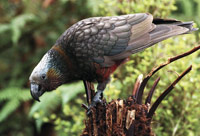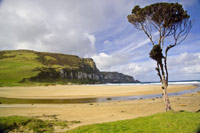 Southland History
Southland History
Southland | Regional Information | Activity Highlights | Scenic Highlights | History
From early Māori heritage, to the legendary Burt Munro, to the petrified forest on the Catlins Coast, you will find evidence of New Zealand's history everywhere in Southland.
Southland History Overview

Photographer: Venture Southland
(www.southlandnz.com)
The first Europeans on the South Island's southern coast were the sealers of the late 1700s. Others intent on harvesting flax came in the early 1800s while whalers began arriving from 1829. Sailors, traders, and entrepreneurs followed.
Māori had arrived over 600 years prior to the first Europeans and bountiful fish and birds attracted seafaring Māori to Bluff. They became exceptional crafters of stone tools, supplying them to Māori nation wide.
Māori quickly became involved in the growing economy; amongst other things, they were heavily involved in the flax trade, whaling and supplying ships with food. Each Māori settlement had its own name however much of the region we now call Southland, is referred to by Māori as Murihiku. According to Māori legend, Murihiku is the last joint in the tail of the fish that is the South Island.
Maui's Anchor Stone
The creation of New Zealand is described by the legend of Maui. This demi-god was hugely talented and managed, among other things, to harness the sun in order to make the days longer. His biggest claim to fame was fishing up of the North Island, which in the Māori language is called Te Ika a Maui (the fish of Maui).
If you look at an aerial map of New Zealand, you'll see how the North Island resembles a fish. Māori believe the far north to be the tail of the fish and Wellington Harbour the mouth. Māori describe the South Island as Maui's waka (canoe) and Stewart Island (Rakiura) as his punga (anchor).
The World's Fastest Indian
Southland motorcycle legend Burt Munro was a man who held on to the dreams of his youth and ultimately realized them.
In the late 1960s, after a lifetime of perfecting his classic Indian motorcycle, Burt Munro set out from Invercargill to Bonneville Salt Flats, Utah, to realise his dreams and clock his bike. Though the odds were against Munro, his determined Kiwi spirit saw him ultimately triumph and set a new land speed record on his bike. Burt Munro is still heralded as a legend today.
In 2006 New Zealand director Roger Donaldson told Burt Munro's story of dream fulfillment and hard work in "The World's Fastest Indian" (portrayed by Anthony Hopkins).
Waituna Lagoon and Wetland
Waituna Lagoon (also known as Lake Waituna) and wetlands was one of the first sites in the world to be named "a wetland of international significance" under the RAMSAR Convention, an intergovernmental treaty that was signed in Ramsar, Iran in 1971.
The area is an important habitat for birds, fish and eels. It is also home to some very unusual plants, such as the cushion plant Donatia which normally grows in sub-alpine areas. Seventy six species of birds have been recorded here, including international migratory waders. The lagoon is a significant trout fishery—fly fishermen enjoy trying to outwit the wily sea-run brown trout. The flatness of the area makes Waituna great for walking—through farmland, across peat country and out onto the reserve.
Catlins Coastal Heritage Trail

Catlins Coast, Southland
Photographer: Ian Brodie
(ibrodie@nzfpm.co.nz)
The Catlins Coastal Heritage Trail is a detour off the Southern Scenic Route, which runs between Dunedin and Te Anau. The trail is a series of walks and places of interest linked by easy drives. You need to allow at least five hours to visit all the places of interest and complete all the walks.
If you follow the trail from north to south, you'll begin at Niagara Falls—a very short waterfall, named by a surveyor with a keen sense of humour. The next place of interest is a concrete horse trough, used by early horse teams. At Waikawa there's a museum displaying photographs and memorabilia from the area. Opposite is the former St Mary's Anglican Church. From the wharf there is a twenty minute walk along the beach on what was once a coach road.
Porpoise Bay is the next stop—home to the rare Hector's dolphin. Nearby is Curio Bay, a world renowned fossil forest best viewed at low tide. Travel on to Waipohatu, a forest area with picnic sites and walks, before you venture onto Slope Point, the most southerly point of the South Island.
Return to the main road and the Tararua Acre, situated 300 metres from the road. This is the burial site of casualties from the wreck of the SS Tararua, which ran aground on 24 April 1881.
Your final port of call is Fortrose, where there is a blacksmith's shop and the area's oldest European cemetery.
» Catlins Coastal Heritage Trail Information
Useful Southland Links
To help plan your Southland holiday choose from the main categories below:
- Southland Accommodation
- Southland Tours
- Southland Attractions and Activities
- Southland Transport
- Southland Cuisine and Dining
- Southland Shopping
- Southland Visitor Information
Southland Region Information
 Regional Information
Regional Information
Key information and facts about the Southland region.
 Activity Highlights
Activity Highlights
Major activities and attractions in the Southland region.
 Scenic Highlights
Scenic Highlights
Major natural attractions in the Southland region.
 History
History
History of the Southland region.
Southland Tourism Operators
Choose from our accommodation, attractions, tours, transport or visitor information categories below to find a tourism operator in Southland.















